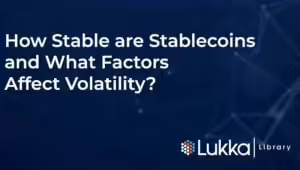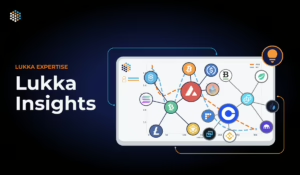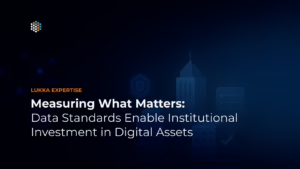Author: Kirk Phillips, CPA, CMA, CFE, CBP; Global Crypto Advisors, Inc.
The discussion in this document reflects legal principles as of March 31, 2020.
Stablecoin starter
Stablecoins are cryptocurrencies designed to maintain price stability, most typically with a peg to an underlying asset. Cryptocurrencies are extremely volatile and have a weak unit of account value. Bitcoin is an excellent medium of exchange and store of value, but it wouldn’t work as a reporting currency for financial statement or tax return purposes because of the volatility. Merchants who accept crypto have to worry about profit margin erosion if the value of a bitcoin dropped sharply after receiving payment from a customer. Volatility risk doesn’t make sense in the ordinary course of selling goods and services, and this limitation has hindered adoption of cryptocurrencies. Stablecoins have essentially become the holy grail in crypto, creating the bridge between traditional finance and the new world of blockchains and programmable money.
Example definitions of stablecoins:
- “A stablecoin is a cryptocurrency that is collateralized to the value of an underlying asset.” Blockdata1
- “Stablecoins, in their most ideal form, are simply cryptocurrencies with stable value.” Multicoin Capital2
- Stablecoins are crypto assets that maintain a stable value against a target price (e.g., USD). Consensys3
Types of stablecoins
There are two broad categories of stablecoins:
- Asset-backed (more prevalent)
- Algorithmic
There are two broad categories of asset-backed stablecoins (with subcategories)
- Off-chain collateral (more prevalent)
- Fiat currency (more prevalent)
- Commodities
- On-chain collateral
- Cryptocurrency 4
There are many different kinds of stablecoins and different ways to collateralize the token. The simplest version is a USD stablecoin backed by USD or a Euro stablecoin backed by Euros. Stablecoins could also be a “basket” of multiple fiat currencies, commodities or other assets. The possibilities for creating stablecoins is almost endless.
Value Proposition
A USD stablecoin can be held in a crypto wallet or on an exchange along with other cryptocurrencies dramatically increasing liquidity when a holder needs to move from one position to another. The friction of cashing out from crypto held in a wallet to USD in a bank account bears significant time and cost, which can be eliminated by stablecoins. Stablecoins effectively turn fiat currency and other assets into cryptocurrencies because stablecoins can be traded as quickly as any other crypto-to-crypto trade.
Centralization and complexity
Off-chain collateral stablecoins are centralized models, whereas algorithmic and off-chain collateral stablecoins are decentralized models solely using blockchains and smart contracts. Centralized models are much less complicated than decentralized models that require more complex stabilization mechanisms. The more complex the stabilization scheme, the more risk and likelihood of higher volatility in the long run. Blockdata describes the challenge of the algorithmic approach, “Stablecoins relying on a combination of algorithms and smart contracts to maintain price equilibrium, it requires continual network growth and investment to provide capital and support a falling currency value.”5
Fiat stablecoin issuance & redemption
The general process for fiat stablecoin issuance and redemption works as follows. Let’s say Stablecoin issuer (SC) onboards Bob with KYC AML checks to create his new account. Bob deposits USD into his new account and purchases new fiat stablecoins on a 1:1 basis “minted” by SC. Bob can send his stablecoins to an exchange to buy bitcoin or pay subcontractors. When Bob wants to redeem his stablecoins, he sends them to his SC account and clicks redeem. SC issuer “burns” Bob’s stablecoins and credits his account for USD at a 1:1 ratio. SC issuer may have authorized issuers who do the procedures on SC’s behalf. 6
Supply & demand
If stablecoin issuers were the only gatekeepers for creating and burning stablecoins, then the “fiat peg” would always remain at $1. Every time customers purchase tokens, they get minted, and every time customers sell tokens, they get burned. However, assets always end up in marketplaces, and stablecoins are no different. Bob can buy or sell his SC tokens on an exchange at the market price rather than redeem or purchase them from the issuer. The supply and demand dynamics are the same as any other cryptocurrency, thus creating prices higher or less than $1 at any given time.
Pernice, Henningsen, et al. explain this principle, “Fundamentally, all stabilization techniques are based on the elementary economic model of supply and demand. The price of a currency can be modeled as the level at which its supply and demand meet each other on the market. A change in price is, therefore due to changes in supply and/or demand—to maintain stability, any such change has to be counteracted.”7
Market Snapshot
Stablecoins do not entirely reflect the price of the underlying asset(s). For example, USD stablecoins prices fluctuate on any given day. Let’s examine a few fiat-backed stablecoins examples from Coinmarketcap on 3-18-20.
- Tether $.994625
- Paxos Standard $.991184
- Binance USD $.988693
- TrueUSD $.991375
- USD Coin $.988230
Two of the above prices fluctuated by more slightly more than 1% and most of the time fluctuations are less than 1% over or under $1.00. The basic economics of supply and demand explain some variations, but depending on the type of stablecoins, there can be many factors in play.
Asset correlations
The volatility in markets for traditional asset classes and the volatility of the real assets underlying stablecoins has almost no spillover effect into cryptocurrencies, including stablecoins. If Bitcoin and Ethereum experience wild price fluctuations or a particular stablecoin undergoes a black swan event, for example, stablecoin volatility gets impacted as a whole. In a 2019 study de Boyrie, Kanchanapoom, et al. state, “Surprisingly, for the stablecoins under study, we find little volatility spillover from gold prices to the gold-backed coins under study or from the USD index to the USD-backed coins. The largest amount of spillover to stablecoins comes from shocks in the stablecoin market, followed by either BTC or ETH market shocks.” They go on the explain, “Furthermore, cross-market volatility spillovers from shocks originating in equity, foreign exchange, and physical gold markets appear limited, while shocks to Bitcoin and Ethereum affect the forecast error variance of gold- and USD-backed stablecoins to a much larger extent.” 8
Synthetic money supply
Stablecoins are essentially derivatives that add another level of complexity and risk relative to any underlying assets. Underlying assets fluctuate in value, and cryptocurrency fluctuates in value, so a combination of the two results in volatility greater than its parts. As a result, stablecoins can be inherently more susceptible to volatility when developers combine crypto features with price stability. The CFA institute states, “The unique characteristics of derivatives, however, pose some complexities not associated with assets, such as equities and fixed-income instruments.” 9
In a Brief History of Stablecoins, Bittrex describes stablecoins as Synthetic Crypto Money (MSC) on top of the M0, M1, M2, M3, and MZM layers in money supply theory with risk and volatility increasing at each additional layer. They explained, “The technical challenges involved in creating such systems are often underestimated. Indeed, constructing a distributed stablecoin system, which is robust enough to withstand cycles or the turbulence and volatility linked to financial markets, may be almost impossible…A stablecoin system that builds on top of the US Dollar is, therefore, never going to be more reliable than traditional banking in our view.” However advanced or sophisticated the distributed stablecoin technology is, we believe the token is likely to be less robust than the layers above it in the money supply tree.” Robustness could be in the eyes of the beholder; however, as the benefits of programmability and liquidity may be well worth any additional volatility. 10
Zero interest and seigniorage
Fiat-backed stablecoins earn revenue by investing their USD reserves, for example, in interest-bearing accounts or US Treasury bills. Depending on the stablecoin, they may also charge a small issuance and redemption fee. The Fed lowered the federal funds rate to zero percent in March 2020 while the interest rates on T-bills went into negative territory. The primary revenue model for fiat-backed stablecoins evaporated overnight, considering the potential for an extended period of zero percent interest.
CoinDesk columnist JP Koning summed it up, “Seigniorage is the word we usually use to describe the profits accruing to issuers of 0 percent-yielding tokens. It’s what helps keep the lights on at the various stablecoin issuers… Assuming the issuers invested $4 billion of their customers’ funds in T-bills and kept $1 billion in liquid no-interest accounts, that comes out to around $100 million in expected interest income at the end of July [2019] ($4 billion x 2.5 percent). But now that $100 million has evaporated to $0. Goodbye, seigniorage.” 11
Skittish investors are flocking to safe investments and away from volatile cryptocurrencies and stocks during the Coronavirus pandemic, driving up demand for USD stablecoins. Suddenly, zero interest stablecoins look more appealing than negative interest rate Treasury bills creating more demand-side pressure on stablecoin prices. “And since [stablecoins] are backed by dollars, they are both affected by global changes in demand for the US currency as well as the monetary policy of the Federal Reserve. As demand increases, investors bid up the price of a token beyond one dollar. That creates an incentive for arbitrage firms to step up and introduce more supply into the system until the spread closes,” explains crypto researcher Hasu. 12
Some stablecoin issuers may shut down, start charging fees, or weather revenue losses from other business lines. Nonetheless, it may be a bumpy road going into unchartered territory, but the value proposition of stablecoins means they are here to stay.
Tether case study
Tether (USDT), a first-mover USD stablecoin with a storied history, remains on the top 10 cryptocurrency list by market cap. Tether claims to have USD bank reserves at a minimum 1:1 ratio; however, it’s struggled to obtain an audit of reserves and maintain banking relationships. In October 2018, Tether posted a blog stating it was pausing fiat deposits due to “processing complications.”13 The markets reacted considering Tether’s battered reputation and plunged to $.87 per token or a 13% discount. Meanwhile, TrueUSD (TUSD), USD stablecoin competitor, traded up to $1.07, a 7% premium.14 In April 2019, Tether disclosed it only had 74% USD reserves backing the token in response to a complaint initially filed by the NY State Attorney General. Zoe Phillips of law firm Morgan Lewis said, “The markets clearly remain confident in tether, as it currently trades just shy of $1 dollar per U.S. Dollar tether — even after the Attorney General’s highly inflammatory and misleading public application.” 15
Tale of irrational behavior
In the first situation, a blog post about operational problems and solvency speculation led to a market discount. In the second situation, a court disclosure of significant under collateralized USD reserves, counter to the company’s promise, led to continued market trading at par around $1.00. Logic would dictate a market response opposite of what happened. It may be difficult to predict the factors specifically affecting Tether’s price, but investor perceptions play a significant role. Besides, Tether has a first-mover advantage beginning in 2014, but amid all the drama competitors haven’t been able to challenge its incumbent status thus far while Tether accounted for 98% of daily stablecoin exchange volume and 93% of market value as of 2018. 16
DAI case study
DAI is an on-chain crypto asset-backed stablecoin created by MakerDAO on the Ethereum blockchain using smart contracts. Users create a collateralized debt position (CDP) on the Oasis dApp (decentralized app) with ETH (the Ethereum token) at a minimum 150% over-collateralization to “mint” DAI. For example, Alice creates a 200% CDP with $20,000 worth of ETH by minting 10,000 DAI. Alice could have collateralized at 150%, but if the price of ETH ever drops below the current value, her CDP would automatically liquidate. One DAI is a 1:1 soft peg to the US dollar, which requires more complicated stability mechanisms to maintain parity. In contrast, the USD stablecoins, as mentioned above, are off-chain, fiat asset-backed stablecoins which keep a 1:1 hard peg via USD reserves. MakerDAO is a completely on-chain decentralized stablecoin model, the antithesis of the centralized fiat model.
Black swans
Oasis users have to post ETH and other tokens to achieve a 150% collateralization ratio, which is a governing mechanism to weather the volatility. DAI and Oasis CDPs experienced a black swan event on March 12, 2020, when the price of ETH plummeted about 40% in several hours. The MakerDAO whitepaper describes the phenomenon, “A black swan event is a rare and critical surprise attack on a system. For the Maker Protocol, examples of a black swan event include…a large, unexpected price decrease of one or more collateral types.”17 The protocol relies on price oracles, which lag behind trading activity, so the price plunge resulted in a massive liquidation and some cases, CDP holders lost all their collateral. 18 Demand for DAI spiked to $1.10, as reported on Coinmarketcap.com, as frantic CDP holders rushed to close out portions or increase the collateral ratio by paying back DAI. The Ethereum network was over congested spiking gas prices (network fees) and preventing CDP holders from avoiding the black swan liquidation event. The DAI price is inherently more susceptible to volatility because the stability fee, savings rate, price oracles, governance, and other mechanisms are designed to create the $1 USD soft peg parity, which is more challenging to achieve than a hard peg.
Risk-adjusted par value
Volatility analysis should also consider additional risk because not all stablecoins are the same. Modern portfolio theory considers risk-adjusted returns when comparing returns among investment categories. The same approach should apply to stablecoins by considering a risk-adjusted “par” value. At first glance, USD-backed stablecoins would seem to have the same risk-adjusted par value, but maintaining 1:1 reserves is only part of the picture. Who is the custodian? Where and how are the assets managed? How can the reserves be verified? Does a CPA audit the reserves? How often are the reserves audited? These are a few risk-based due diligence questions to consider.
Examples to highlight the stark contrast between two fiat stablecoins:
- Tether’s (USDT) Terms of Service, section 12 states, Tether makes no representations, warranties, or guarantees to you of any kind. 19 Further, a “Proof of Funds” button on the front page of their website (as of March 2020) goes to an attorney letter dated June 1, 2018. The letter is not evidence of an official audit, and it’s almost two years old. 20
- True USD (TUSD), on the other hand, has a “real-time reserves” header at the top of their website. A “Generate Real-time Attest Opinion” button is available by clicking on the header. The button generates a timestamped CPA opinion letter in real-time on Armanino, LLCs website, the attesting CPA firm. Previously Trust Token, the TUSD issuer, published mostly CPA reports on its website. 21
Opposites
The two examples are at opposite ends of the spectrum, and therefore the risk is entirely different. If price reflected the risk-adjusted par value, then Tether should be trading at a discount, and True USD should be trading at a premium. Meanwhile, Tether continues to dominate the stablecoin market. Apply the same approach to assessing risk for different gold-backed stablecoins or any collateralized stablecoins.
Conclusion
The economics of supply and demand explain some price fluctuations, but many other factors can cause more extreme volatility. Stablecoins, in general, are synthetic assets or derivatives which introduce more complexity and risk because they are layered on top of underlying assets on the money supply tree, for example. In some cases, irrational market behavior, as identified in the Tether case study, has an unpredictable effect on price. Research indicated overall stablecoin volatility resulted from shocks in the cryptocurrency market and, more specifically, Bitcoin and Ethereum in addition to shocks of particular stablecoins rather than spillover shocks from traditional asset markets. There are wide-ranging types of stablecoins and with over 100 projects announced since 2017. 22 The Blockchain Stablecoin Report stated, “Further, it is unlikely that a single design is optimal for all use cases. In other words, which stablecoin is ‘best’ depends upon a wide variety of sometimes competing factors, including intended use (e.g., short-term trading store of value), degree of desired trust minimization and decentralization, regulatory/jurisdictional compliance, scalability.” 23 The complexity of decentralized stablecoins such as algorithmic and on-chain crypto asset-backed stablecoins have more inherent risk and are more volatile exemplified by the DAI black swan event. Finally, consider risk-adjusted par value when evaluating stablecoins even though the market doesn’t appear to reflect that over the long term, as evidenced by the Tether and TrueUSD comparison.
1 Schweiger, Lucas. “STABLECOINS An Overview of the Current State of Stablecoins.” Blockdata, 2018, download.blockdata.tech/blockdata-stablecoin-report-blockchain-technology.pdf.
2 Samani, Kyle. “An Overview of Stablecoins.” Multicoin Capital , 17 Jan. 2018,
multicoin.capital/2018/01/17/anoverview-of-stablecoins.
3 Sexer, Nathan. “State of Stablecoins, 2018.” State of Stablecoins, 2018, Consensys, 24 July 2018, media.consensys.net/the-state-of-stablecoins-2018-79ccb9988e63.
4 Blockchain.com , Research. “2019 STATE OF STABLECOINS.” 2019, www.blockchain.com/research.
5 Schweiger, Lucas. “STABLECOINS An Overview of the Current State of Stablecoins.” Blockdata, 2018, download.blockdata.tech/blockdata-stablecoin-report-blockchain-technology.pdf.
6 Circle , FAQs. “How Does USDC Work Technically?” How Does USDC Work Technically?, 2020, www.centre.io/usdc-faq.
7 Pernice, Ingolf, et al. “Monetary Stabilization in Cryptocurrencies—Design Approaches and Open Questions.”, 28 May 2019, arxiv.org/pdf/1905.11905.pdf.
8 De Boyrie, Marie, et al. “Stablecoins and Volatility.” 2019, editorialexpress.com/cgibin/conference/download.cgi?db_name=SWFA2019&paper_id=251.
9 CFA, Institute. “Basics of Derivative Pricing and Valuation.” Basics of Derivative Pricing and Valuation, 2020, www.cfainstitute.org/en/membership/professional-development/refresher-readings/2020/basics derivativepricing-valuation.
10 BitMEX, Research. “A Brief History of Stablecoins (Part 1).” 2 July 2018, blog.bitmex.com/a-brief-history ofstablecoins-part-1/.
11 Koning, JP. “Zero Interest Rates Could Hamper the Stablecoin Business.” CoinDesk , 1 Apr. 2020, www.coindesk.com/zero-interest-rates-could-hamper-the-stablecoin-business.
12 Hasu. “USD Stablecoins Are Surging, but Zero Interest Rates Complicate Business Model.” CoinDesk, 30 Mar. 2020, www.coindesk.com/usd-stablecoins-are-surging-but-zero-interest-rates-complicate-business-model.
13 Bitfinex. “Fiat Deposit Update .” 15 Oct. 2018, medium.com/bitfinex/fiat-deposit-update-october-15th 201818ddd276c3fd.
14 Morse, Jack. “Sudden Price Drop Shows Largest ‘Stablecoin,’ Tether, Isn’t so Stable after All.” Mashable, 15 Oct. 2018, mashable.com/article/stablecoin-cryptocurrency-tether-price-drop/.
15 Suberg, William. “Fractional Reserve Stablecoin Tether Only 74% Backed by Fiat Currency, Say Lawyers.” 30 Apr. 2019, cointelegraph.com/news/fractional-reserve-stablecoin-tether-only-74-backed-by-fiat-currencysay lawyers.
16 Blockchain.com. “The State of Stablecoins.” 2018, www.blockchain.com/ru/static/pdf/StablecoinsReportFinal.pdf.
17 Maker, DAO. “The Maker Protocol: MakerDAO’s Multi-Collateral Dai (MCD) System.” 2020, makerdao.com/en/whitepaper#introduction.
18 Fitzner, Blockchain. “Maker’s Black Swan Reviewing the Aftermath of Last Week’s Events for MakerDAO.” Token Tuesdays , 17 Mar. 2020, tokentuesdays.substack.com/p/makers-black-swan.
19 Tether. “Tether Terms of Service .” 26 Feb. 2019, tether.to/legal.
20 Freeh, Sporkin Sullivan LLP. “Proof of Funds Letter.” 15 June 2018, tether.to/wpcontent/uploads/2018/06/FSS1JUN18-Account-Snapshot-Statement-final-15JUN18.pdf.
20 Armanino, LLP. “Trust Explorer Real-Time Audit.” 2020, real-time-attest.trustexplorer.io/.
21 Schweiger, Lucas. “STABLECOINS An Overview of the Current State of Stablecoins.” Blockdata, 2018, download.blockdata.tech/blockdata-stablecoin-report-blockchain-technology.pdf.
22 Schweiger, Lucas. “STABLECOINS An Overview of the Current State of Stablecoins.” Blockdata, 2018, download.blockdata.tech/blockdata-stablecoin-report-blockchain-technology.pdf.
23 Blockchain.com. “The State of Stablecoins.” 2018, www.blockchain.com/ru/static/pdf/StablecoinsReportFinal.pdf.



